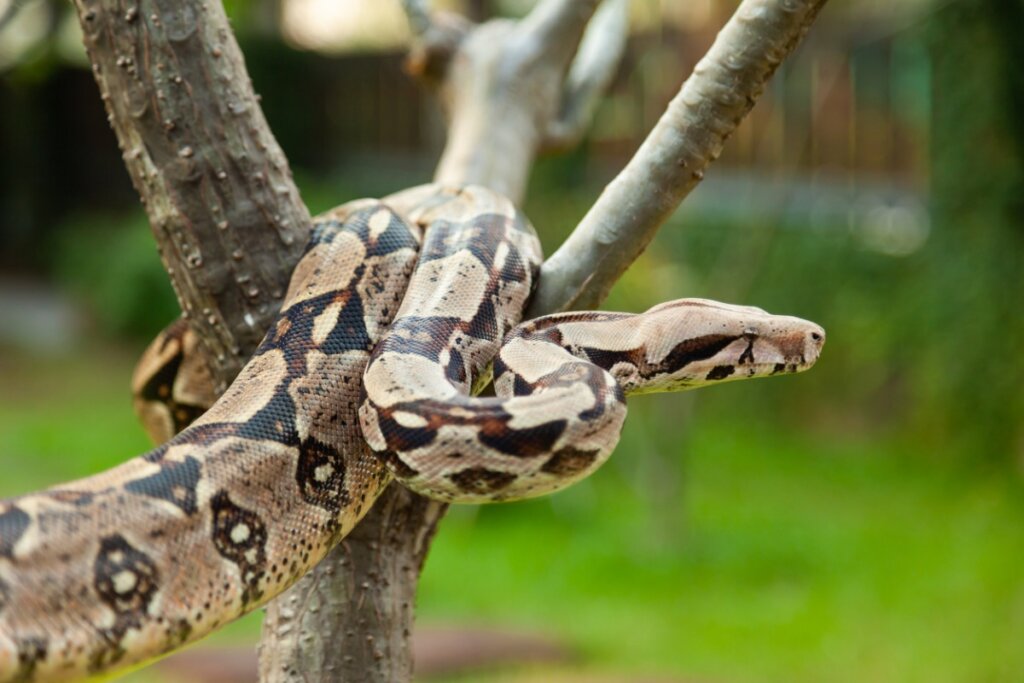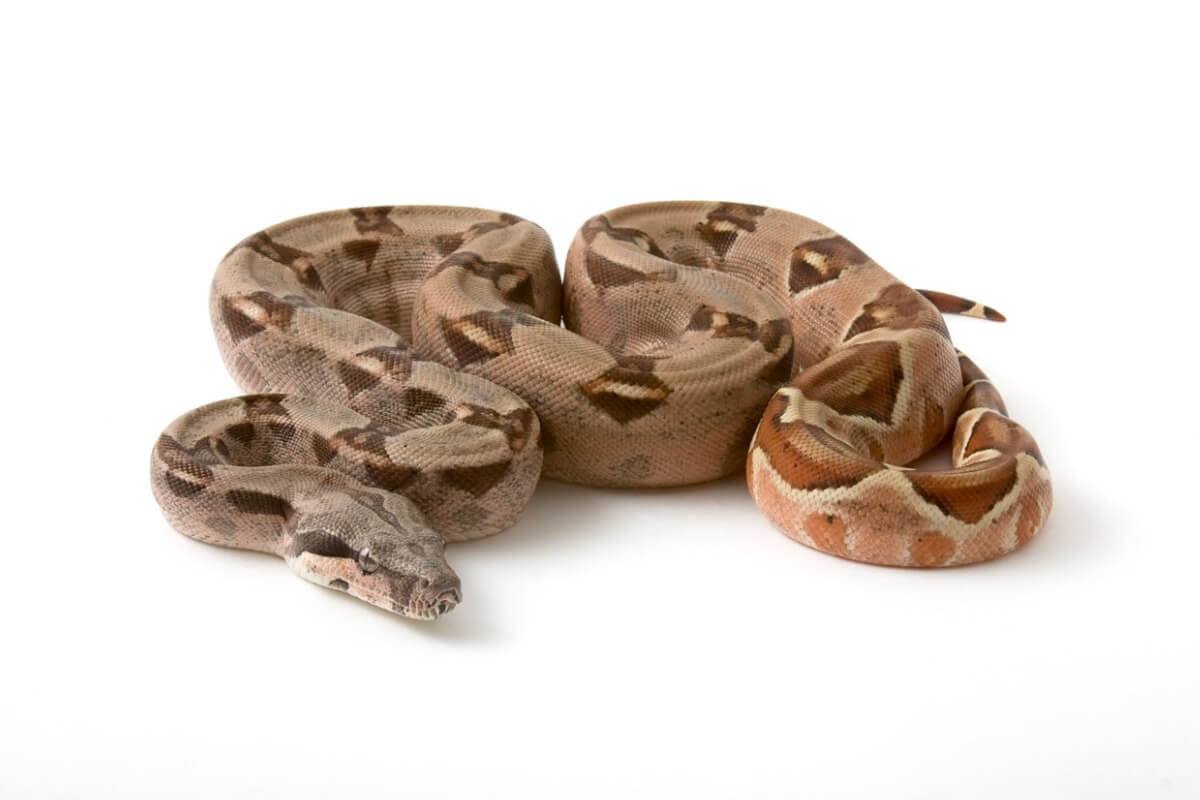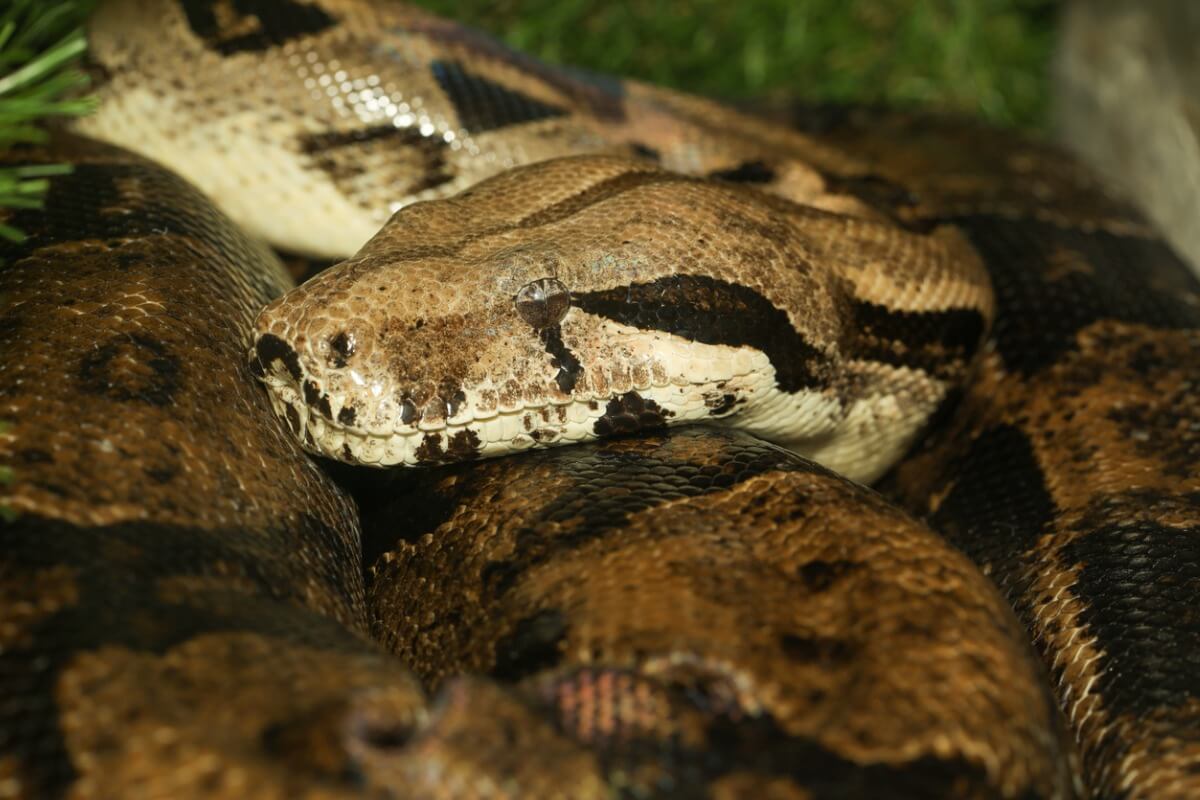Looking After a Boa Constrictor

Despite their intimidating appearance, snakes are a common sight in the homes of reptile lovers. However, looking after a boa constrictor care is quite tricky, and it isn’t an exotic animal that’s suitable for beginners.
If you intend to start gathering information about how to look after this species, here’s a basic guide that will show you everything a boa needs in captivity. Don’t miss it.
Boa constrictor characteristics
The boa constrictor is an ophidian belonging to the Boidae family. There are 8 subspecies recognized within this taxon whose size can vary from 1.5 meters in length up to 4 meters (5 to 13 feet). They’re quite heavy reptiles, reaching body masses of up to 40 kilograms (88 pounds).
They’re quite long-lived reptiles that reach 40 years of age in captivity with proper care.
This snake is distributed throughout practically the entire American continent. It occupies habitats with low humidity, such as deserts and savannahs, although it’s sometimes found in humid forests. It’s capable of climbing trees and resting on branches.
This snake is called a constrictor because of the way it hunts: it first catches its prey with a bite and then coils around it. Once in this position, it constricts the animal with force, preventing it from breathing and crushing its bones to swallow it better. Constrictor snakes aren’t poisonous, but they can kill a human being.

Important things to consider when looking after a boa constrictor
The first and most important thing to consider before you get one is whether looking after a boa constrictor is legal in your country. In some places (such as Spain) the trade and possession of this species of snake isn’t allowed. The boa constrictor is listed in Appendix II of CITES.
The aim of these regulations is to curb illegal trade and prevent certain animals from becoming an invasive species.
If your country allows you to keep a boa and you get all the necessary documentation for it, then the next step will be to find all the information you need about the subspecies that you’re going to take home. For example, the size it can reach will be very relevant to its proper housing and handling.
You should seriously consider whether you can, or should, take a carnivorous, non-domesticated, solitary, crepuscular animal into your home. You’ll have to feed it other animals, learn to handle an ophidian that’s capable of reaching 4 meters and 40 kilos, and pay its high living costs. In addition, the animal will require care for up to 40 years.
Feeding a boa constrictor
The boa should always have clean, fresh water available, preferably bottled. You should also provide it with a container it can bathe in, especially during its shedding time.
The boa constrictor’s main diet will be small mammals. Depending on the size of the snake, prey can range from mice to rabbits, guinea pigs, rats, and other rodents. One small mammal a week is usually sufficient, but the frequency of feeding will depend on the animal and its needs.
It’s advisable to feed the snake at dusk, when it begins its peak activity.
Ideally, get the boa used to eating already dead animals, otherwise you may encounter accidents if the prey defends itself. Although the victims can be bought frozen in specialized stores, offer them warm bodies, preferably heated in a pot of boiling water.
After eating, let the snake rest, as its digestion is slow and heavy. If you see it regurgitate the prey, it may have been too big.
Boa constrictor terrarium
When looking after a boa constrictor, the quality of its terrarium is one of the most important things. The best housing for this ophidian is a terrarium that is taller than it is wide and large enough to hold a branch, a shelter, and a water bowl. The purpose of this is to allow the boa to display its natural tree climbing behavior.
How big should a boa constrictor terrarium be? There’s no standard size, as it’ll depend on the size of the animal itself. Here are some approximate measurements:
- Hatchlings: A small snake can adapt to live in a terrarium of 60 x 50 x 30 centimeters (2 x 1.6 x 1 feet) in length, width, and height. This terrarium will be temporary, as it’ll grow and you’ll have to change it.
- Young: When the snake reaches adulthood and measures up to 2 meters (6.6 feet) in length, the minimum size of the terrarium will be 150 x 90 x 70 centimeters in length, width and height (5 x 3 x 2.3 feet).
- Adults: Once the boa reaches its maximum size, it can’t be kept in a terrarium any smaller than 300 x 100 x 70 centimeters in length, height and width (10 x 3.3 x 2.3 feet). However, it’s best to keep the animal in as large an enclosure as possible.
It will work out cheaper for you if you move the snake to its final terrarium when it reaches adulthood. A small one will make it easier to handle when it’s a baby, but when you change it, do it only once and get the largest container you can.
Acclimatization of the terrarium
Snakes are ectothermic animals, which means that their body temperature depends largely on the environment. This means that another of the most important care tips for a boa constrictor is to maintain optimal humidity and temperature parameters for their well-being.
The ideal temperature for a boa constrictor is between 24 and 26° C and should never fall below 22° C. There are many heat sources suitable for snakes, but the best are heating plates and ceramic heat lamps that don’t emit light.
Don’t allow the snake to be in direct contact with the heat source to avoid accidental burns.
Humidity is another essential factor to control. For this species, it should be between 50 and 60%, 70-75% to avoid dysecdysis during molting. Using a quality substrate will help stabilize the humidity inside the terrarium. Hemp or coconut fiber are good choices for this.
Terrarium items
Designing and setting up the terrarium is, for many people, the most enjoyable task involved in boa constrictor care. It’s a satisfying and specialized process, ideal for those who enjoy researching and creating the best environments for their animal.
The main components of a terrarium are the substrate, shelter, and enrichment. Let’s look at them one by one:
- Substrate: As mentioned above, the ideal substrate is hemp or coconut fiber. Some people also use poplar bark. However, make sure you aren’t sold cedarwood, as this is toxic to many reptiles.
- Shelter: Since the boa rests during the day and has to regulate its body temperature, it’s a good idea to put two shelters in your facility, one in the hot area and one in the cold area. In this way, the reptile has a choice. Fix the shelter solidly and provide a method of access, such as a branch, so that it can climb up to it.
- Other elements: The branches and the pool of water are elements that allow the snake to display natural behavior. This serves as enrichment and prevents health problems.
How to clean a boa constrictor terrarium
A thorough cleaning of the terrarium should be carried out at least once a month, perhaps more often if the snake is large. Remove feces and other organic debris from the substrate daily, always carefully and keeping an eye on the animal at all times.
Keep in mind that a closed terrarium with heat sources and animal remains is a perfect substrate for the proliferation of fungi, bacteria and parasites.
For cleaning, it’s best to use a mixture of 10% bleach and 90% water. For glass you can use an alcoholic solution specifically for cleaning glass. Use cloths that don’t leave any residue and make sure you rinse off any remaining bleach. Also thoroughly clean all the elements of the terrarium.

As you can see, there are many basic ideas about looking after a boa constrictor. If you want to take on the great responsibility of looking after a snake like this, we recommend that you always have a trusted veterinarian and reptile specialist available. They’ll be the one who will best guide you when it comes to keeping your snake healthy.
All cited sources were thoroughly reviewed by our team to ensure their quality, reliability, currency, and validity. The bibliography of this article was considered reliable and of academic or scientific accuracy.
- CITES. (2021). Boa constrictor. https://cites.org/esp/gallery/species/reptile/boa_constrictor.html
- Boa constrictor (Boa Constrictor). (s. f.). Animal Diversity Web. Recuperado 4 de noviembre de 2021, de https://animaldiversity.org/accounts/Boa_constrictor/
- Apéndice Cites I y II. (2021, 22 junio). Cites.org. Recuperado 20 de octubre de 2021, de https://cites.org/esp/app/appendices.php
- Kottwitz, J., & Coke, R. (2007). Unusual Pet Care Volumen IV: Vol. IV. Zoological Education Network.